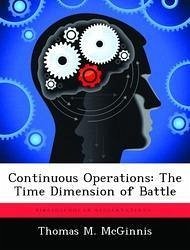
Continuous Operations: The Time Dimension of Battle
Versandkostenfrei!
Versandfertig in über 4 Wochen
52,99 €
inkl. MwSt.

PAYBACK Punkte
26 °P sammeln!
This paper examines the conduct of continuous operations from the theoretical, historical and doctrinal perspective. To define the problem, it begins with an overview of the recent research in the field. It then closely examines a division which successfully conducted continuous operations during World War II. Finally, it reviews current American and Soviet doctrine on the subject to determine if it addresses the issues raised by the theory and case study. The division studied in the case study is the 104th Infantry Division in its battles from the Roer River to the Rhine River from 23 Februar...
This paper examines the conduct of continuous operations from the theoretical, historical and doctrinal perspective. To define the problem, it begins with an overview of the recent research in the field. It then closely examines a division which successfully conducted continuous operations during World War II. Finally, it reviews current American and Soviet doctrine on the subject to determine if it addresses the issues raised by the theory and case study. The division studied in the case study is the 104th Infantry Division in its battles from the Roer River to the Rhine River from 23 February to 7 March 1945. The division's performance is analyzed from activation through this operation using the available historical records. The analysis of the battles focuses on the division's tactical conduct of operations. It concludes that current theory only partially explains the issues involved. Current theory and doctrine have focused primarily on the performance limits of the individual soldier and the conduct of night operations. However, the experience of the 104th Division shows that many more factors are involved in successful continuous operations. Areas contributing to the success which are addressed in current doctrine include training, soldier welfare and night operations. However, the key to the division's execution of continuous operations was an awareness by the command group that the division would be fighting for extended periods. Consequently, it employed its regiments and battalions in such a way that it could conduct operations around the clock with fresh soldiers at all times. The command group employed the division over time as well as over the terrain of the battle.














